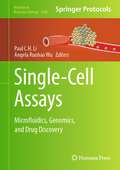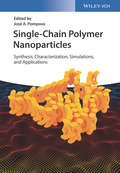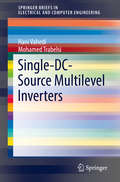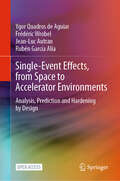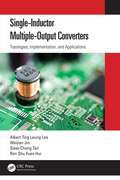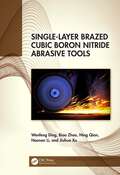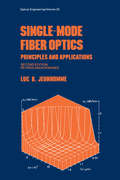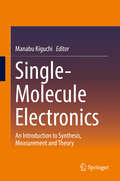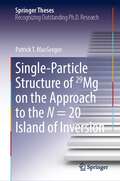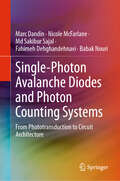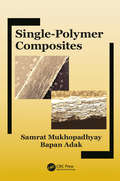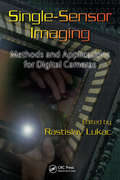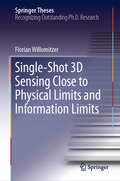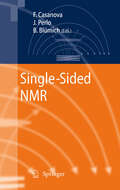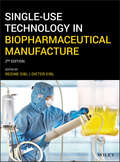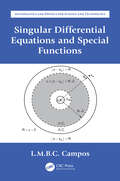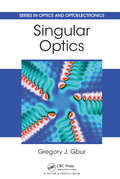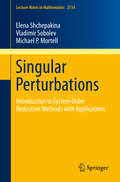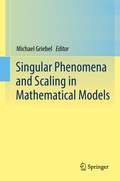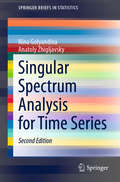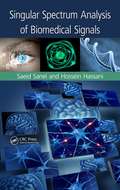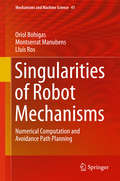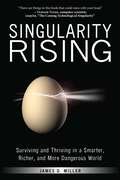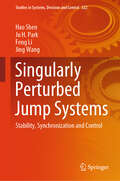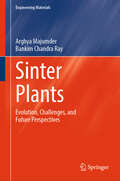- Table View
- List View
Single-Cell Assays: Microfluidics, Genomics, and Drug Discovery (Methods in Molecular Biology #2689)
by Paul C. H. Li Angela Ruohao WuThis detailed volume explores the use of single-cell assays in research for drug discovery, microfluidics, and more. The book delves into methodologies involving a variety of cell types and diseases, small molecules and biologics, as well as studies of the genome and transciptome. Written in the highly successful Methods in Molecular Biology series format, chapters include introductions to their respective topics, lists of the necessary materials and reagents, step-by-step and readily reproducible laboratory protocols, and tips on troubleshooting and avoiding known pitfalls. Authoritative and practical, Single-Cell Assays: Microfluidics, Genomics, and Drug Discovery serves to enable researchers to obtain a rapid overview in state-of-the-art microfluidic single-cell assays and an impression of what possibilities these assays offer to drug discovery.
Single-Chain Polymer Nanoparticles: Synthesis, Characterization, Simulations, and Applications
by Jose A. PomposoThis first book on this important and emerging topic presents an overview of the very latest results obtained in single-chain polymer nanoparticles obtained by folding synthetic single polymer chains, painting a complete picture from synthesis via characterization to everyday applications. The initial chapters describe the synthetics methods as well as the molecular simulation of these nanoparticles, while subsequent chapters discuss the analytical techniques that are applied to characterize them, including size and structural characterization as well as scattering techniques. The final chapters are then devoted to the practical applications in nanomedicine, sensing, catalysis and several other uses, concluding with a look at the future for such nanoparticles. Essential reading for polymer and materials scientists, materials engineers, biochemists as well as environmental chemists.
Single-DC-Source Multilevel Inverters (SpringerBriefs in Electrical and Computer Engineering)
by Hani Vahedi Mohamed TrabelsiThe purpose of the book is to distinguish the single-de-source multilevel inverter topologies and to teach their control, switching and voltage balancing. It will include new information on voltage balancing and control of multilevel inverters. The book will answer some important questions about the revolution of power electronics converters: 1- Why multilevel inverter are better than 2-level ones? 2- Why single-de-source multilevel inverters are a matter of interest? 3- What are the redundant switching states and what do they do? 4- How to use redundant switching states in control and voltage balancing? 5- What are the applications of single-de-source multilevel inverters?
Single-Event Effects, from Space to Accelerator Environments: Analysis, Prediction and Hardening by Design
by Jean-Luc Autran Ygor Quadros Aguiar Frédéric Wrobel Rubén García AlíaThis book describes the fundamental concepts underlying radiation-induced failure mechanisms in electronic components operating in harsh environments, such as in space missions or in particle accelerators. In addition to providing an extensive overview of the dynamics and composition of different radiation environments, the authors discuss the failure mechanisms, known as single-event effects (SEEs), and dedicated failure modeling and prediction methodologies. Additionally, novel radiation-hardening-by-design (RHBD) techniques at physical layout and circuit levels are described. Readers who are newcomers to this field will learn the fundamental concepts of particle interaction physics and electronics hardening design, starting from the composition and dynamics of radiation environments and their effects on electronics, to the qualification and hardening of components. Experienced readers will enjoy the comprehensive discussion of the state-of-the-art in modeling, simulation, and analysis of radiation effects developed in the recent years, especially the outcome of the recent European project, RADSAGA. Describes both the fundamental concepts underlying radiation effects in electronics and state-of-the-art hardening methodologies Addresses failure mechanisms, known as single-event effects (SEEs), and dedicated failure modeling and prediction methodologies Reveals novel radiation-hardening-by-design (RHBD) techniques at physical layout and circuit levels Offers readers the first book in which particle accelerator applications will be extensively included in the radiation effects context This is an open access book.
Single-Inductor Multiple-Output Converters: Topologies, Implementation, and Applications
by Ron Shu Hui Albert Ting Lee Weijian Jin Siew-Chong TanThe book provides a comprehensive overview of Single-Inductor Multiple-Output Converters from both theoretical and practical perspectives. Based on the authors’ in-depth research, the volume covers not only conventional SIMO DC-DC converters but also the new generations of SIMO such as SIMO AC-DC converters, SIMO DC-AC converters (or SIMO inverters), and the latest SIMO hybrid converters. This book offers a holistic and systematic presentation of all types of SIMO converters, encompassing the derivation of the circuit topologies, the definition of key concepts, detailed discussion of theoretical underpinnings, design methodology and control schemes, as well as design considerations and techniques that enable practical implementation. Specific examples of real-world applications of SIMO converters are also provided. The volume offers a comprehensive overview and systematic classification of the traditional and modern topologies of SIMO converters in terms of system architecture, circuit analysis, operating principles, control methods, design considerations and practical implementation. Specifically, the book presents the mathematical models and design principles necessary for analyzing the behavior of each kind of SIMO converter, and building upon that, introduces and imparts new approaches and techniques when designing such converters, guiding engineering students and power engineers towards achieving low-cost, compact and energy efficient SIMO converters. offers the design considerations and optimization as well as describing the key applications of SIMO converters. The book fills a significant niche in the power electronics literature and provides a complete perspective on SIMO converters that hopefully can inspire appreciation and better understanding of the subject matter. It can be directly adopted in undergraduate or graduate coursework as well as postgraduate research programs.
Single-Layer Brazed Cubic Boron Nitride Abrasive Tools
by Wenfeng Ding Biao Zhao Ning Qian Haonan Li Jiuhua XuThis book systematically summarises the state-of-the-art research in the field of single-layer brazed cubic boron nitride (CBN) abrasive tools in terms of manufacturing technology, wear mechanisms and machining performance. The authors present manufacturing methods and related principles, and explore the wear behaviour and mechanisms of single-layer brazed CBN abrasive tools, providing insights into tool manufacturing and tool life. They also clarify the scientific issues in the grinding performance of single-layer brazed CBN abrasive tools to improve machining efficiency and quality. The book will contribute to the development of aerospace engineering and inspire academic researchers and industrial engineers in the field of ultra-high precision machining, especially grinding.
Single-Mode Fiber Optics: Prinicples and Applications, Second Edition,
by Luc B. JeunhommeA basic, unified reference, rather than a description of the current experimental activity, presenting the scientific and engineering principles of single-mode optical fibers. It does, however, update discussions to reflect developments since the 1983 first edition, particularly those on international standards for fibres and measurement procedures, improvements in fibre attenuation control, fibre gyrometry, high-birefringence fibres, dispersion shifted and dispersion flattened fibres, connectors and splicing equipment, long distance terrestrial and undersea communication systems, and long distance transmissions systems.
Single-Molecule Electronics
by Manabu KiguchiThis book presents a multidisciplinary approach to single-molecule electronics. It includes a complete overview of the field, from the synthesis and design of molecular candidates to the prevalent experimental techniques, complemented by a detailed theoretical description. This all-inclusive strategy provides the reader with the much-needed perspective to fully understand the far-reaching ramifications of single-molecule electronics. In addition, a number of state-of-the-art topics are discussed, including single-molecule spectro-electrical methods, electrochemical DNA sequencing technology, and single-molecule chemical reactions. As a result of this integrative effort, this publication may be used as an introductory textbook to both graduate and advanced undergraduate students, as well as researchers with interests in single-molecule electronics, organic electronics, surface science, and nanoscience.
Single-Particle Structure of 29Mg on the Approach to the N = 20 Island of Inversion (Springer Theses)
by Patrick T. MacGregorThe nuclear shell model has had much success when describing nuclear structure. It is able to describe the single-particle states of nuclei, and gives understanding as to how nuclear structure evolves as the number of nucleons changes in a nucleus. This led to the discovery of the so-called magic numbers, which designate particularly stable configurations of protons and neutrons in nuclei.With the advent of radioactive ion beams, it has become possible to probe exotic nuclei to test current theories of nuclear structure. These investigations have led to the discovery of exotic nuclear phenomena, with structures different to those found in stable nuclei. One of these is the N=20 island of inversion, where configurations that appear in stable nuclei become less bound than more exotic particle-hole configurations across a shell gap. Another is the weakening of the magic N=20 shell gap to N=16 as the number of protons is reduced in this isotonic chain.Of particular interest are the magnesium isotopes, which exhibit a swift transition into the island of inversion with 29Mg lying outside and 31Mg lying inside. In addition, 29Mg lies one neutron outside N=16, so is also able to give insight on the weakening of the N=16 shell gap. Mapping this region of the chart of nuclides helps in the understanding of the evolution of this nuclear structure. A useful probe for this task is single-particle transfer reactions. However, these reactions have been hindered by low yields from radioactive ion beams, as well as suffering from kinematic effects that obscure the states that need to be observed. The ISOLDE Solenoidal Spectrometer (ISS), that measures these transfer reactions in a solenoidal magnetic field, was designed to counteract these effects. With the high-yield radioactive ion beams at ISOLDE, CERN, these transfer reactions became viable.Therefore, the nuclear structure of 29Mg was probed using the d(28Mg,p) reaction using this device. This work marks the first measurement using the ISOLDE Solenoidal spectrometer and the first time that a solenoidal spectrometer has been used at an ISOL radioactive beam facility. The measurements highlight the interplay of nucleon-nucleon interactions and the geometry of the nuclear potential in driving observed trends in single-particle structure, in particular the changes in closed shells towards doubly magic 24O
Single-Photon Avalanche Diodes and Photon Counting Systems: From Phototransduction to Circuit Architecture
by Marc Dandin Nicole McFarlane Md Sakibur Sajal Fahimeh Dehghandehnavi Babak NouriThis book covers the latest trends in the design of single-photon avalanche diodes (SPADs), which are the front-end sensors in modern photon counting systems. The authors describe the fundamental physics that enable photon counting in these devices. They also discuss systems that are made from these detectors, specifically describing circuit architectures that may be used to achieve high-fidelity photon counting. Coverage features example devices and systems designed in the authors’ research groups as well as different approaches undertaken by other experts in the field. The authors take a unique, modular approach that covers every aspect of the design stack, with stand-alone chapters, allowing readers to focus on specific aspects of the technology stack. Coverage includes the device-physics aspects of the detectors, their integration in modern electronics fabrication technologies like CMOS, and application-specific systems that utilize these detectors.
Single-Polymer Composites
by Samrat Mukhopadhyay Bapan AdakThis book discusses the concept of single polymer composites (SPCs), their preparation, and properties and the main factors which affect the manufacturing of this class of composites. It deals with the leading classes of polymers, chapter wise, which have been majorly explored for manufacturing SPCs – polyolefins, polyesters, polyamides, and LCPs – includes a case study on manufacturing of SPCs, and devotes three chapters to detailed analyses of research on all-cellulose composites. Addressing the concerns of the researchers, it also answers intriguing questions in the field of SPCs with pointers to the right references. Key Features Presents a summary of single polymer composites based on various polymers Includes mechanical and thermal properties of single polymer composites Reviews detailed view of eco-friendly approaches to composites Offers a special focus on all-cellulose composites Supports concepts with figures, schemes, and tables
Single-Sensor Imaging: Methods and Applications for Digital Cameras (Image Processing Series)
by Rastislav LukacA Decade of Extraordinary GrowthThe past decade has brought a surge of growth in the technologies for digital color imaging, multidimensional signal processing, and visual scene analysis. These advances have been crucial to developing new camera-driven applications and commercial products in digital photography. Single-Sensor Imaging: Methods and Applications for Digital Cameras embraces this extraordinary progress, comprehensively covering state-of-the-art systems, processing techniques, and emerging applications.Experts Address Challenges and Trends Single-Sensor Imaging: Methods and Applications for Digital Cameras presents leading experts elucidating their own accomplishments in developing the technologies reshaping this field. The editor invited renowned authorities to address specific research challenges and recent trends in their particular areas of expertise. The book discusses single-sensor digital color imaging fundamentals, including reusable embedded software platform, digital camera image processing chain, optical filter and color filter array designs. It also details the latest techniques and approaches in contemporary and traditional digital camera color image processing and analysis for various sophisticated applications, including: Demosaicking and color restoration White balancing and color transfer Color and exposure correction Image denoising and color enhancement Image compression and storage formats Red-eye detection and removal Image resizing Video-demosaicking and superresolution imaging Image and video stabilization A Solid Foundation of Knowledge to Solve Problems Single-Sensor Imaging: Methods and Applications for Digital Cameras builds a strong fundamental understanding of theory and methods for solving many of today’s most interesting and challenging problems in digital color image and video acquisition, analysis, processing, and storage. A broad survey of the existing solutions and relevant literature makes this book a valuable resource both for researchers and those applying rapidly evolving digital camera technologies.
Single-Shot 3D Sensing Close to Physical Limits and Information Limits (Springer Theses)
by Florian WillomitzerThis thesis discusses the physical and information theoretical limits of optical 3D metrology, and, based on these principal considerations, introduces a novel single-shot 3D video camera that works close to these limits. There are serious obstacles for a “perfect” 3D-camera: The author explains that it is impossible to achieve a data density better than one third of the available video pixels. Available single-shot 3D cameras yet display much lower data density, because there is one more obstacle: The object surface must be “encoded” in a non-ambiguous way, commonly by projecting sophisticated patterns. However, encoding devours space-bandwidth and reduces the output data density. The dissertation explains how this profound dilemma of 3D metrology can be solved, exploiting just two synchronized video cameras and a static projection pattern.The introduced single-shot 3D video camera, designed for macroscopic live scenes, displays an unprecedented quality and density of the 3D point cloud. The lateral resolution and depth precision are limited only by physics. Like a hologram, each movie-frame encompasses the full 3D information about the object surface and the observation perspective can be varied while watching the 3D movie.
Single-Sided NMR
by Bernhard Blümich Federico Casanova Juan PerloThis book describes the design of the first functioning single-sided tomograph, the related measurement methods, and a number of applications in medicine, materials science, and chemical engineering. It will be the first comprehensive account of this new device and its applications. Among the key advances of this method is that images can be obtained in much shorter times than originally anticipated, and that even vector maps of flow fields can be measured although the magnetic fields are highly inhomogeneous. Furthermore, the equipment is small, mobile and affordable to small and medium enterprises and can be located in doctors' offices.
Single-Use Technology in Biopharmaceutical Manufacture
by Regine Eibl Dieter EiblAuthoritative guide to the principles, characteristics, engineering aspects, economics, and applications of disposables in the manufacture of biopharmaceuticals The revised and updated second edition of Single-Use Technology in Biopharmaceutical Manufacture offers a comprehensive examination of the most-commonly used disposables in the manufacture of biopharmaceuticals. The authors—noted experts on the topic—provide the essential information on the principles, characteristics, engineering aspects, economics, and applications. This authoritative guide contains the basic knowledge and information about disposable equipment. The author also discusses biopharmaceuticals’ applications through the lens of case studies that clearly illustrate the role of manufacturing, quality assurance, and environmental influences. This updated second edition revises existing information with recent developments that have taken place since the first edition was published. The book also presents the latest advances in the field of single-use technology and explores topics including applying single-use devices for microorganisms, human mesenchymal stem cells, and T-cells. This important book: • Contains an updated and end-to-end view of the development and manufacturing of single-use biologics • Helps in the identification of appropriate disposables and relevant vendors • Offers illustrative case studies that examine manufacturing, quality assurance, and environmental influences • Includes updated coverage on cross-functional/transversal dependencies, significant improvements made by suppliers, and the successful application of the single-use technologies Written for biopharmaceutical manufacturers, process developers, and biological and chemical engineers, Single-Use Technology in Biopharmaceutical Manufacture, 2nd Edition provides the information needed for professionals to come to an easier decision for or against disposable alternatives and to choose the appropriate system.
Singular Differential Equations and Special Functions (Mathematics and Physics for Science and Technology)
by Luis Manuel Braga da Costa CamposSingular Differential Equations and Special Functions is the fifth book within Ordinary Differential Equations with Applications to Trajectories and Vibrations, Six-volume Set. As a set they are the fourth volume in the series Mathematics and Physics Applied to Science and Technology. This fifth book consists of one chapter (chapter 9 of the set). The chapter starts with general classes of differential equations and simultaneous systems for which the properties of the solutions can be established 'a priori', such as existence and unicity of solution, robustness and uniformity with regard to changes in boundary conditions and parameters, and stability and asymptotic behavior. The book proceeds to consider the most important class of linear differential equations with variable coefficients, that can be analytic functions or have regular or irregular singularities. The solution of singular differential equations by means of (i) power series; (ii) parametric integral transforms; and (iii) continued fractions lead to more than 20 special functions; among these is given greater attention to generalized circular, hyperbolic, Airy, Bessel and hypergeometric differential equations, and the special functions that specify their solutions. Includes existence, unicity, robustness, uniformity, and other theorems for non-linear differential equations Discusses properties of dynamical systems derived from the differential equations describing them, using methods such as Liapunov functions Includes linear differential equations with periodic coefficients, including Floquet theory, Hill infinite determinants and multiple parametric resonance Details theory of the generalized Bessel differential equation, and of the generalized, Gaussian, confluent and extended hypergeometric functions and relations with other 20 special functions Examines Linear Differential Equations with analytic coefficients or regular or irregular singularities, and solutions via power series, parametric integral transforms, and continued fractions
Singular Optics (Series in Optics and Optoelectronics)
by Gregory J. Gbur"This engagingly written text provides a useful pedagogical introduction to an extensive class of geometrical phenomena in the optics of polarization and phase, including simple explanations of much of the underlying mathematics." —Michael Berry, University of Bristol, UK "The author covers a vast number of topics in great detail, with a unifying mathematical treatment. It will be a useful reference for both beginners and experts…." —Enrique Galvez, Charles A. Dana Professor of Physics and Astronomy, Colgate University "a firm and comprehensive grounding both for those looking to acquaint themselves with the field and those of us that need reminding of the things we thought we knew, but hitherto did not understand: an essential point of reference." —Miles Padgett, Kelvin Chair of Natural Philosophy and Vice Principal (Research), University of Glasgow This book focuses on the various forms of wavefield singularities, including optical vortices and polarization singularities, as well as orbital angular momentum and associated applications. It highlights how an understanding of singular optics provides a completely different way to look at light. Whereas traditional optics focuses on the shape and structure of the non-zero portions of the wavefield, singular optics describes a wave’s properties from its null regions. The contents cover the three main areas of the field: the study of generic features of wavefields, determination of unusual properties of vortices and wavefields that contain singularities, and practical applications of vortices and other singularities.
Singular Perturbations
by Elena Shchepakina Vladimir Sobolev Michael P. MortellThese lecture notes provide a fresh approach to investigating singularly perturbed systems using asymptotic and geometrical techniques. It gives many examples and step-by-step techniques, which will help beginners move to a more advanced level. Singularly perturbed systems appear naturally in the modelling of many processes that are characterized by slow and fast motions simultaneously, for example, in fluid dynamics and nonlinear mechanics. This book's approach consists in separating out the slow motions of the system under investigation. The result is a reduced differential system of lesser order. However, it inherits the essential elements of the qualitative behaviour of the original system. Singular Perturbations differs from other literature on the subject due to its methods and wide range of applications. It is a valuable reference for specialists in the areas of applied mathematics, engineering, physics, biology, as well as advanced undergraduates for the earlier parts of the book, and graduate students for the later chapters.
Singular Phenomena and Scaling in Mathematical Models
by Michael GriebelThe book integrates theoretical analysis, numerical simulation and modeling approaches for the treatment of singular phenomena. The projects covered focus on actual applied problems, and develop qualitatively new and mathematically challenging methods for various problems from the natural sciences. Ranging from stochastic and geometric analysis over nonlinear analysis and modelling to numerical analysis and scientific computation, the book is divided into the three sections: A) Scaling limits of diffusion processes and singular spaces, B) Multiple scales in mathematical models of materials science and biology and C) Numerics for multiscale models and singular phenomena. Each section addresses the key aspects of multiple scales and model hierarchies, singularities and degeneracies, and scaling laws and self-similarity.
Singular Spectrum Analysis for Time Series (SpringerBriefs in Statistics)
by Anatoly Zhigljavsky Nina GolyandinaThis book gives an overview of singular spectrum analysis (SSA). SSA is a technique of time series analysis and forecasting combining elements of classical time series analysis, multivariate statistics, multivariate geometry, dynamical systems and signal processing. SSA is multi-purpose and naturally combines both model-free and parametric techniques, which makes it a very special and attractive methodology for solving a wide range of problems arising in diverse areas. Rapidly increasing number of novel applications of SSA is a consequence of the new fundamental research on SSA and the recent progress in computing and software engineering which made it possible to use SSA for very complicated tasks that were unthinkable twenty years ago. In this book, the methodology of SSA is concisely but at the same time comprehensively explained by two prominent statisticians with huge experience in SSA. The book offers a valuable resource for a very wide readership, including professional statisticians, specialists in signal and image processing, as well as specialists in numerous applied disciplines interested in using statistical methods for time series analysis, forecasting, signal and image processing. The second edition of the book contains many updates and some new material including a thorough discussion on the place of SSA among other methods and new sections on multivariate and multidimensional extensions of SSA.
Singular Spectrum Analysis of Biomedical Signals
by Saeid Sanei Hossein HassaniRecent advancements in signal processing and computerised methods are expected to underpin the future progress of biomedical research and technology, particularly in measuring and assessing signals and images from the human body. This book focuses on singular spectrum analysis (SSA), an effective approach for single channel signal analysis, and its
Singularities of Robot Mechanisms
by Oriol Bohigas Montserrat Manubens Lluís RosThis book presents the singular configurations associated with a robot mechanism, together with robust methods for their computation, interpretation, and avoidance path planning. Having such methods is essential as singularities generally pose problems to the normal operation of a robot, but also determine the workspaces and motion impediments of its underlying mechanical structure. A distinctive feature of this volume is that the methods are applicable to nonredundant mechanisms of general architecture, defined by planar or spatial kinematic chains interconnected in an arbitrary way. Moreover, singularities are interpreted as silhouettes of the configuration space when seen from the input or output spaces. This leads to a powerful image that explains the consequences of traversing singular configurations, and all the rich information that can be extracted from them. The problems are solved by means of effective branch-and-prune and numerical continuation methods that are of independent interest in themselves. The theory can be put into practice as well: a companion web page gives open access to implementations of the algorithms and the corresponding input files. Using them, the reader can gain hands-on experience on the topic, or analyse new mechanisms beyond those examined in the text. Overall, the book contributes new tools for robot design, and constitutes a single reference source of knowledge that is otherwise dispersed in the literature.
Singularity Rising: Surviving and Thriving in a Smarter, Richer, and More Dangerous World
by James D. MillerIn Ray Kurzweil's New York Times bestseller The Singularity is Near, the futurist and entrepreneur describes the Singularity, a likely future utterly different than anything we can imagine. The Singularity is triggered by the tremendous growth of human and computing intelligence that is an almost inevitable outcome of Moore's Law. Since the book's publication, the coming of the Singularity is now eagerly anticipated by many of the leading thinkers in Silicon Valley, from PayPal mastermind Peter Thiel to Google co-founder Larry Page. The formation of the Singularity University, and the huge popularity of the Singularity website kurzweilai.com, speak to the importance of this intellectual movement. But what about the average person? How will the Singularity affect our daily lives—our jobs, our families, and our wealth? Singularity Rising: Surviving and Thriving in a Smarter, Richer, and More Dangerous World focuses on the implications of a future society faced with an abundance of human and artificial intelligence. James D. Miller, an economics professor and popular speaker on the Singularity, reveals how natural selection has been increasing human intelligence over the past few thousand years and speculates on how intelligence enhancements will shape civilization over the next forty years. Miller considers several possible scenarios in this coming singularity: A merger of man and machine making society fantastically wealthy and nearly immortal Competition with billions of cheap AIs drive human wages to almost nothing while making investors rich Businesses rethink investment decisions to take into account an expected future period of intense creative destruction Inequality drops worldwide as technologies mitigate the cognitive cost of living in impoverished environments Drugs designed to fight Alzheimer's disease and keep soldiers alert on battlefields have the fortunate side effect of increasing all of their users' IQs, which, in turn, adds a percentage points to worldwide economic growth Singularity Rising offers predictions about the economic implications for a future of widely expanding intelligence and practical career and investment advice on flourishing on the way to the Singularity.
Singularly Perturbed Jump Systems: Stability, Synchronization and Control (Studies in Systems, Decision and Control #522)
by Jing Wang Feng Li Ju H. Park Hao ShenIn this book, various singularly perturbed jump system models in continuous-time or discrete-time domain, such as Markov jump singularly perturbed systems, semi-Markov jump singularly perturbed systems, hidden Markov jump singularly perturbed systems, and singularly perturbed jump complex network model, have been considered for some control synthesis problems. Also, some partial probability information cases are taken into account when addressing those control synthesis problems. To show the effectiveness and applicability of the obtained results, some numerical examples and practical industrial model examples are given.
Sinter Plants: Evolution, Challenges, and Future Perspectives (Engineering Materials)
by Bankim Chandra Ray Arghya MajumderThis book provides a comprehensive examination of sintering technology and the crucial role it plays in the steelmaking process. The book begins with an introduction to the historical evolution of sintering, outlining its significance in modern steel production. Subsequent chapters delve into the fundamentals of sintering, raw materials and sinter mix composition, various sintering technologies, and optimization techniques for sinter plant operations. Environmental considerations, energy efficiency, and sustainability are thoroughly explored, alongside discussions on digitalization, automation, and quality assurance in sintering processes and its implications. The book also features case studies and industry examples from around the world, highlighting real-world challenges, innovative solutions, and best practices in sinter plant operations. Additionally, it provides insights into future trends and developments in sintering technology, offering a forward-looking perspective on the future of sinter plants and the steel industry as a whole. This book is an essential resource for engineers, researchers, and industry professionals seeking to deepen their understanding of sintering technology and navigate the complexities of modern steel production. With its comprehensive coverage, insightful analysis, and forward-looking perspective, the book emerges as a seminal work in the field of metallurgy.
